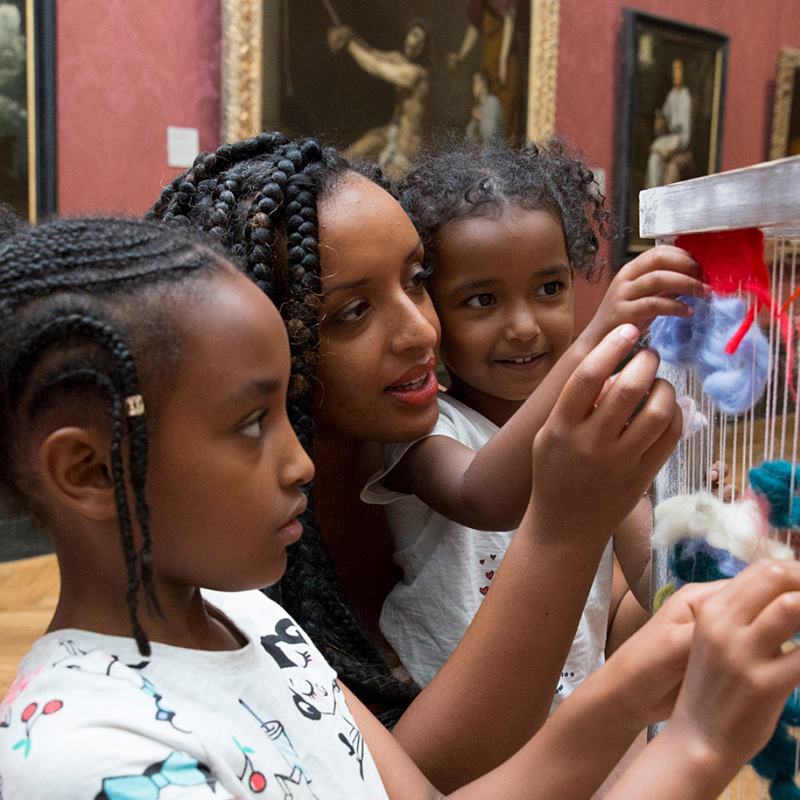Christ prays before a group of cherubs who hold up the instruments of his torture and death.
His disciple Judas, who has betrayed him, leads a large band of soldiers down from Jerusalem to arrest him.
Meanwhile his other disciples sleep.
This panel shows the moment, described in the Gospels, when Jesus Christ was arrested by Roman soldiers.
The soldiers are on the right in elaborate armour; their helmets were originally silver but the silver leaf has darkened over time.
They were accompanied by chief priests from the Jewish Temple – the bearded men on the left of the scene.
‘Ecce Homo’, the Latin title of this painting, is taken from the Bible, and means ‘Behold the man!’ These were the words of Pontius Pilate, the Roman governor of Judea, when he was sitting as the judge during the trial of Christ.
Pilate, here shown wearing a turban and rising to his feet, is presenting Christ to the crowd. Christ stands slightly higher than his captors – he’s the only figure looking upwards towards the ’true' judge, God.
Tied to a column, Christ has collapsed to the floor. His limp body, tilted head and pained expression show his exhaustion and suffering.
Velázquez shows the moment after the Flagellation, when Christ was flogged by Roman soldiers – we can see the sticks and whip they used lying in the foreground. The brutality of this assault is implied by trickles and spots of blood on Christ’s body and the column.
Christ’s body hangs from the Cross, which is surmounted with the inscription ‘I.N.R.I.’, which stands for Iesus Nazarenus Rex Iudaeorum (‘Jesus of Nazareth, King of the Jews’).
Two angels with scrolling ribbons at their waists balance on delicate slivers of cloud on either side of Christ. They catch the blood flowing from his wounds in golden chalices.
A nimble boy at the very top of the painting attempts to support Christ’s weight as his body is removed from the Cross.
Joseph of Arimathea, who had offered up his family tomb for Christ, supports his upper body, which is received by Nicodemus.
The Virgin Mary is slumped on the ground, supported by John the Evangelist, while Mary Magdalene clasps a tense, bony hand to her head in shock and grief.
Here, the limp and lifeless body of Christ lies in the lap of his mother, the Virgin Mary. A distraught Mary Magdalene kneels on the right, hands raised and mouth open in a wail of anguish.
At the back an older woman in dark green reaches out towards the fainting Virgin, whose weight is supported by a fair-haired young woman.
Christ’s body has been taken down from the Cross and is being carried on a shroud to his place of burial.
His head rests limply on his shoulder; his pale, foreshortened body is the focus of a whole retinue of grieving figures, each expressing their sorrow in a different way.
In this unfinished work by Michelangelo, Christ’s body is being carried to his tomb.
Saint John the Evangelist may be the figure on the left carrying Christ’s body helped by one of the Three Marys (the Virgin Mary, Mary Magdalene and Mary Salome).
They carry him up a staircase to his tomb in the rocks. The man behind Christ is either Joseph of Arimathea or Nicodemus.
The space left empty on the right was probably intended for the kneeling figure of the Virgin Mary. The other female figure on the right is probably Mary Salome.
The Roman soldiers who have been posted to guard Christ’s tomb from grave robbers have fallen asleep.
Christ has risen from his grave and is shown above his tomb holding a white flag with a red cross, a symbol of the Resurrection.
The lid of the tomb is still closed, emphasising the miracle of the Resurrection – something that the soldiers couldn't have been prepared for even if they had been awake.
Risen from the dead, Christ appears to his grieving follower, Mary Magdalene, in the Garden of Gethsemane.
At first she mistakes him for a gardener but then reaches out her hand in wonder. Christ says, ‘Do not touch me’ (in Latin, 'noli me tangere'); it is time for his followers to let go of his earthly presence and await the Holy Ghost (John 20: 14–18).
On the third day after the Crucifixion two of Jesus’s disciples were walking to Emmaus when they met the resurrected Christ.
They failed to recognise him, but that evening at supper he ‘... took bread, and blessed it, and brake and gave to them. And their eyes were opened, and they knew him; and he vanished out of their sight’ (Luke 24: 30–31).


























